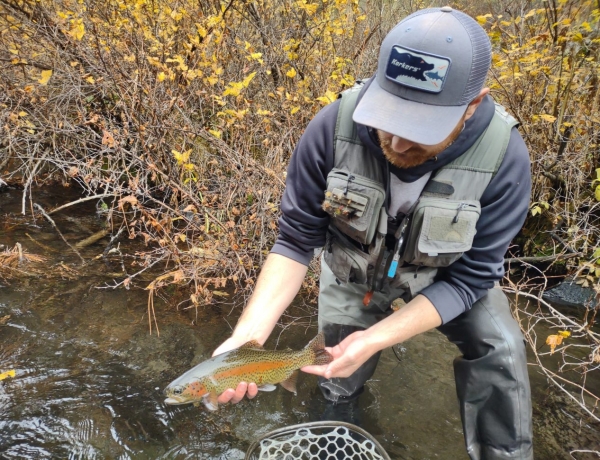The John Day River is a long, low gradient river that flows through northeastern and central Oregon. It is also the longest undammed river in Oregon, and the fourth longest in the U.S. Most of the river is a warmwater fishery for much of the year, with some steelhead available during the colder months depending on if the river is open for them or not. There are also trout available in the headwaters, including Oregon's only population of native westslope cutthroat!
Warmwater
The main warmwater target species on the fly in the John Day is smallmouth bass, with some carp and maybe a channel catfish if you get lucky. In 1971, ODFW planted 80 smallmouth adults in the John Day near Service Creek and scattered smallmouth fry along other parts of the river. From those meager origins, there are now plentiful smallmouth throughout the river from the mouth up to about Kimberly, where the North Fork John Day meets the mainstem. The carp are mostly below Tumwater Falls, but in recent years have been spreading further upstream. Catfish are generally not caught on the fly, but every so often you can get one or two on a streamer pattern, especially in the low water late summer conditions in the upper portion of the warmwater section when the fish are most concentrated. Tactics for the bass are pretty straightforward if you want to just catch any fish. Take a fly, and put it in the water. If it moves, a bass will probably try to eat it. This river is great for kids and new fly anglers because the bass are so opportunistic. To target larger bass, going in the spring when fish are pre-spawn or on their beds can result in bigger average size fish, but it is also very dependent on the flows since the river blows out a lot during that season. Generally, bigger and deeper flies throughout the year will also produce bigger fish. The carp are much spookier, and can be frustrating to target. They are generally benthic feeders, meaning they are eating things on the bottom of the river, but sometimes they will eat things on the surface. Berries, hoppers, even cotton seeds have all been known to be part of the carp diet at certain times of the year. The catfish are also mostly bottom feeders, but in low water fishing things like buggers or crayfish can sometimes produce a surprise channel cat.
Coldwater
Steelhead have been the main draw for coldwater fish on the John Day, but dismal adult returns have closed the river in recent years. The John Day is managed for wild steelhead, meaning it isn't stocked, but hatchery strays do show up from time to time and can be harvested. Like all other steelhead populations east of the Cascades, there are only summer steelhead in the John Day. They typically enter the river in late August at the earliest, around the time the water starts cooling from high summer temps. Long riffles support these fish throughout the fall and winter, and covering a lot of ground is important because there can be quite a distance in between runs that hold fish.
In the headwaters and some of the tributaries, there are also some opportunities for small stream trout fishing. There are Columbia Basin redband, westslope cutthroat, bull trout, whitefish, and invasive brook trout. The upper John Day is unique in that Oregon's only native population of westslope cutthroat inhabit that section. As with the smallmouth down lower, these fish are not very selective. Generic trout flies work throughout, and it's mostly a dealer's choice situation that really just depends on how you want to catch fish. There are some meadow sections, but mostly it is a classic high gradient freestone made of plunge pools and pockets. The fish are not big, and the appeal is the native fish and solitude the upper portion of this watershed provides. Additionally, if you're going to harvest the invasive brook trout, make sure you can confidently tell the difference between bull trout and brook trout. The easiest way is that brook trout will have little squiggly lines on their backs, called vermiculations, and bull trout will not. The brook trout have no limit, whereas the bull trout are listed under the Endangered Species Act, so harvesting a bull trout even by accident would be quite expensive.


